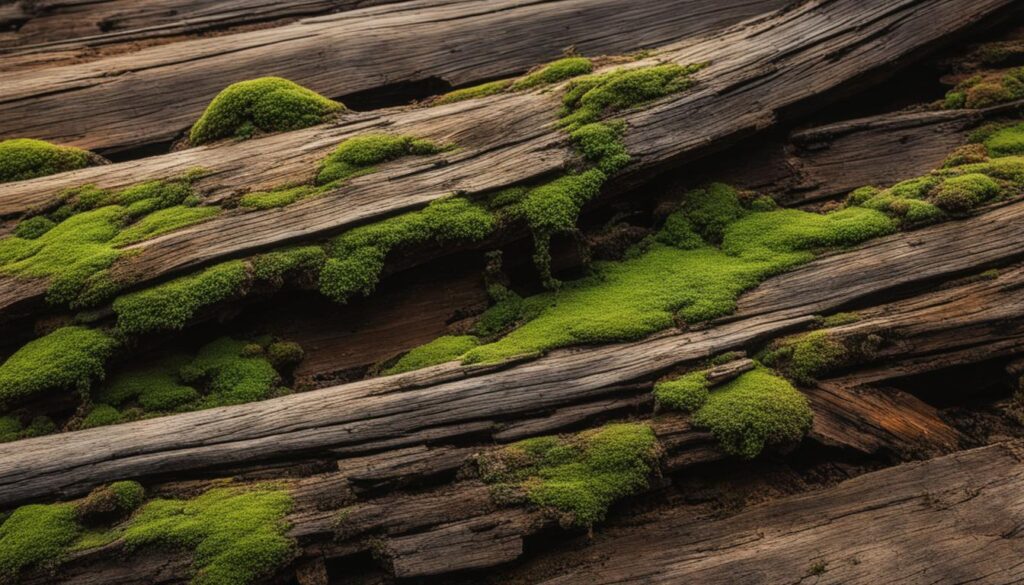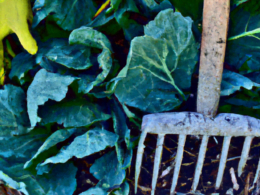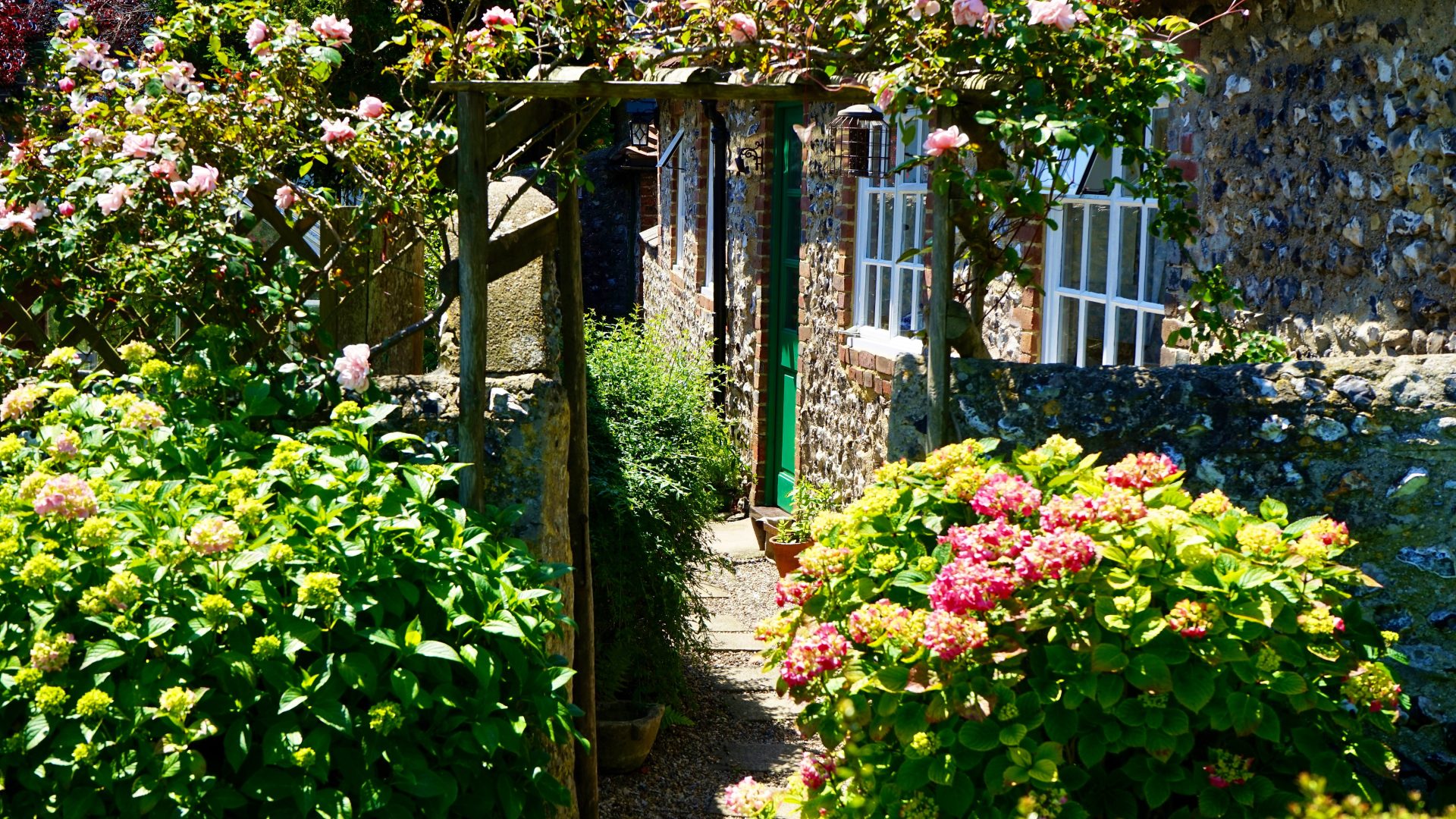Railroad ties have long been a popular choice for gardens and landscapes, thanks to their rustic charm and durability. These wooden structures are commonly used for raised garden beds, retaining walls, steps, and more. However, when considering the use of railroad ties for your garden, it’s essential to understand the potential risks and alternatives available.
Post Summary:
- Railroad ties have a natural, worn look that is aesthetically appealing for raised garden beds and landscaping projects.
- There are different types of railroad ties, including reclaimed ties treated with creosote, a wood preservative.
- Creosote is considered a probable human carcinogen by the EPA, raising concerns about its use in certain situations.
- Using creosote-treated ties in raised vegetable garden beds or areas where children play is not recommended due to the risk of creosote leaching into the soil.
- It is advisable to explore safer alternatives, such as naturally rot-resistant woods or recycled plastic materials, for landscaping projects.
What Are Railroad Ties?
Railroad ties, also known as railway sleepers, are the support system for railroad tracks. They are horizontally laid perpendicular to the rails to provide stability and hold the tracks in place. Typically made of wood, railroad ties have been used for their durability and strength in the railway industry for many years. They play a crucial role in maintaining the structural integrity of the tracks and ensuring safe and efficient train travel.
Traditionally, railroad ties are made from hardwood or softwood that has been treated with creosote, a wood preservative. This treatment helps to protect the wood from rot, decay, and insect infestation, extending the lifespan of the ties. Creosote-treated ties have the characteristic dark brown color and distinct smell associated with the preservative. However, it is important to note that creosote is a potential health and environmental hazard, raising concerns about the safe use of railroad ties in certain applications.
“Railroad ties, also known as railway sleepers, provide the crucial support system for railroad tracks.”
The Role of Railroad Ties in Supporting Railway Tracks
The primary function of railroad ties is to distribute the weight of the trains and their cargo evenly across the track bed. The ties serve as a solid foundation, absorbing and dispersing the load to prevent excessive stress on the tracks and the underlying ground. By maintaining proper spacing between the ties, railroad tracks can withstand heavy loads, resist deformation, and provide a smooth and stable surface for train travel.
| Advantages | Disadvantages |
|---|---|
|
|
While railroad ties continue to be widely used in the railway industry, concerns about their potential health and environmental risks have led to the exploration of alternative materials and treatment methods. It is important to weigh the advantages and disadvantages of railroad ties when considering their use in landscaping and gardening projects, taking into account safety, regulations, and the specific requirements of the application.
Are Railroad Ties Safe?
When considering the use of railroad ties in your landscaping projects, it is important to understand the safety concerns associated with these materials. The main issue lies in the use of creosote, a wood preservative commonly found in railroad ties. Creosote has been classified as a possible human carcinogen by the Environmental Protection Agency (EPA), raising concerns about its impact on human health.
While there are still some areas where the use of creosote-treated railroad ties is legal, it is not recommended to use them in certain situations. Raised vegetable garden beds and areas where children play are particularly at risk, as the creosote can leach into the soil and potentially contaminate plants or pose a health risk to those who come into contact with it.
It is essential to be aware of the potential dangers associated with creosote-treated railroad ties and take appropriate precautions. If you must use these materials, avoid direct contact with the creosote and ensure proper ventilation when working with them. However, it is strongly advised to explore safer alternatives that do not pose a risk to human health and the environment.
Safe Handling and Disposal of Railroad Ties
When handling railroad ties, especially those treated with creosote, it is crucial to follow safety guidelines to minimize exposure to the preservative. Consider the following precautions:
- Wear protective clothing, such as long sleeves, gloves, and a dust mask, to prevent direct contact and inhalation of creosote.
- Avoid using creosote-treated ties near water supplies or in areas where humans and animals will have direct contact with them.
- Do not burn creosote-treated wood, as this can release harmful fumes.
If you are looking for alternative materials for your landscaping projects, there are several options to consider. Utilizing naturally rot-resistant woods like redwood, cedar, or cypress is one safe alternative. Recycled plastic or plastic mixed with sawdust are other viable options that do not leach chemicals into the soil. Additionally, using pavers or rocks can provide both safety and durability for borders and retaining walls.
| Pros of Safer Alternatives | Cons of Creosote-Treated Railroad Ties |
|---|---|
| – Naturally rot-resistant woods are aesthetically pleasing. | – Potential health risks due to creosote leaching into the soil. |
| – Recycled plastic materials are environmentally friendly. | – Not suitable for raised vegetable garden beds or areas where children play. |
| – Pavers and rocks offer a wide range of design options. | – Legal implications and restrictions on the use of creosote-treated ties. |
How to Use Railroad Ties Safely
When using railroad ties for your landscaping projects, it is essential to prioritize safety and take necessary precautions to minimize the risks associated with creosote-treated wood. By following these safety guidelines, you can ensure a safer environment for yourself, your family, and your garden:
- Avoid using creosote-treated railroad ties near water supplies or areas where humans and animals will have direct contact with them. This helps prevent the leaching of creosote into the soil.
- When working with or removing creosote-treated ties, wear protective clothing such as long sleeves, gloves, and a dust mask. This protects you from direct contact and inhalation of harmful substances.
- Do not burn creosote-treated wood, as it releases toxic fumes into the air.
Considering safer alternatives to creosote-treated railroad ties is also highly recommended. Here are some alternatives to consider:
- Choose naturally pest-resistant woods like redwood, cedar, cypress, catalpa, juniper, or Osage orange. These do not require chemical treatment and are safe for use in your garden.
- Recycled plastic or plastic mixed with sawdust can be used as an eco-friendly alternative to wood. They provide similar functionality without leaching any harmful chemicals into the soil.
- Consider using pavers or rocks for borders and retaining walls in your landscaping projects. These materials are durable, safe, and can enhance the aesthetic appeal of your garden.
By following these safety precautions and exploring safer alternatives, you can enjoy the benefits of using railroad ties in your landscaping projects while minimizing potential health risks.
Expert Advice on Using Railroad Ties
If you are considering using railroad ties in your landscaping projects, it is important to seek expert advice. While railroad ties have been traditionally used for gardens and landscapes, there are legal and safety concerns associated with their use, especially when it comes to ties treated with creosote, a potential human carcinogen.
Experts recommend against using old railroad ties for home landscapes, as they are not approved for residential use. The Environmental Protection Agency (EPA) advises against using creosote-treated wood, including railroad ties, for landscaping purposes. If you have concerns about the legality or safety of the ties on your property, it is recommended to consult with professionals who specialize in landscaping and wood treatment to explore alternative options.
“Using old railroad ties in a home landscape is not legal. Creosote, the main preservative in old railroad ties, is not approved for residential use.”
Professional landscapers can provide guidance on safe alternatives to railroad ties that are free from toxic chemicals and pose minimal risks to human health and the environment. They can help you choose materials such as naturally rot-resistant woods like redwood, cedar, or cypress, which do not require chemical treatment. Recycled plastic or plastic mixed with sawdust are also viable alternatives. Additionally, using pavers or rocks for borders and retaining walls can provide a safe and durable alternative to railroad ties.
Potential Risks of Railroad Ties in the Garden
Railroad ties can pose several risks when used in gardens. One of the primary concerns is the potential contamination of the soil. The creosote used to treat the ties can leach out over time, introducing harmful chemicals into the soil. This contamination can have adverse effects on plant growth and may also impact food safety if you are growing edible plants in your garden.
Direct contact with creosote can also be harmful. Whether through topical contact or inhaling its fumes, exposure to creosote can have negative health effects. It is crucial to handle railroad ties with caution and take appropriate safety measures to minimize exposure.
“Railroad ties have the potential to contaminate the soil and pose health risks due to the creosote used in their treatment.”
If you currently have railroad ties in your garden, it is advisable to remove them along with several inches of the surrounding soil. This precaution can help reduce the risk of long-term contamination. Proper handling and disposal of the ties are also essential to minimize exposure to toxic substances.
Potential Risks and Precautions
| Risk | Precautions |
|---|---|
| Soil Contamination | Remove railroad ties and surrounding soil if present. Consider testing the soil for contamination. |
| Health Risks | Handle railroad ties with gloves and avoid inhaling fumes. Wash hands thoroughly after handling. |
| Disposal | Follow local regulations for the proper disposal of creosote-treated materials. |
It is essential to prioritize the safety of your garden and those who come into contact with it. Exploring alternative materials, such as naturally rot-resistant woods or recycled plastic, can help you create a safer and more sustainable landscape. By making informed choices and taking necessary precautions, you can mitigate the potential risks associated with railroad ties and ensure the health of your garden.
Safer Alternatives to Railroad Ties
If you’re looking for safer alternatives to railroad ties for your landscaping projects, there are a few options to consider. These alternatives not only provide similar functionality to wood but also eliminate the potential risks associated with creosote-treated ties.
One option is to use naturally rot-resistant woods such as redwood, cedar, cypress, catalpa, juniper, or Osage orange. These woods do not require chemical treatment and are a sustainable choice for your garden. They offer durability and can withstand outdoor conditions without the need for toxic preservatives.
Another alternative is to use recycled plastic or plastic mixed with sawdust. These materials mimic the appearance of wood but do not leach any chemicals into the soil. They are eco-friendly and low maintenance, making them a popular choice for those looking for a long-lasting and sustainable solution.
Comparison of Safer Alternatives to Railroad Ties
| Alternative | Benefits |
|---|---|
| Naturally Rot-Resistant Wood | – No chemical treatment required – Durable and weather-resistant – Sustainable choice |
| Recycled Plastic or Plastic Mixed with Sawdust | – No chemical leaching – Low maintenance – Eco-friendly option |
Using pavers or rocks for borders and retaining walls is another safe and durable alternative to railroad ties. They come in various shapes and sizes, allowing for creative designs, while also providing structural stability and longevity.
When choosing safer alternatives to railroad ties, it’s essential to consider the specific needs of your landscaping project and the desired aesthetic. By opting for these alternatives, you can create a beautiful and environmentally friendly outdoor space without compromising on safety.
Conclusion
When it comes to using railroad ties for raised garden beds and other landscaping projects, it is important to prioritize safety and consider the potential risks involved. Railroad ties, especially those treated with creosote, can pose health hazards due to the leaching of toxic chemicals into the soil. Therefore, it is advisable to explore safer alternatives that are free from harmful substances.
By following some safety tips, you can minimize the risks associated with railroad ties. When handling creosote-treated ties, always wear protective clothing such as long sleeves, gloves, and a dust mask to avoid direct contact and inhalation of harmful substances. Additionally, it is crucial to avoid using railroad ties near water supplies or areas where humans and animals come into direct contact with them.
For raised garden beds and landscaping structures, look for alternatives that are safer and environmentally friendly. Consider using naturally rot-resistant woods like redwood, cedar, or cypress, which do not require chemical treatment. Recycled plastic or plastic mixed with sawdust is another viable option. Pavers and rocks can also be used as borders and retaining walls, providing a safe and durable alternative to railroad ties.
By prioritizing safety and exploring alternatives, you can create a beautiful and sustainable garden without compromising your health or the environment. So, when planning your next landscaping project, keep in mind the safety tips and alternative options discussed to make informed decisions for a safer and more enjoyable outdoor space.
FAQ
Can I use railroad ties for raised garden beds?
While railroad ties have been commonly used for gardens and landscapes, it is not recommended to use railroad ties, especially those treated with creosote, for raised vegetable garden beds due to the potential health risks associated with creosote leaching into the soil.
What are railroad ties?
Railroad ties are the support for railroad tracks, laid perpendicular to the rails to hold them upright. They are typically made of wood that has been treated with creosote.
Are railroad ties safe?
Railroad ties treated with creosote pose potential health risks. Creosote, the main preservative used in railroad ties, is considered a possible human carcinogen by the EPA. It is not recommended to use creosote-treated ties in certain situations, such as raised vegetable garden beds or areas where children play.
How can I use railroad ties safely?
When using railroad ties, it is important to follow safety precautions to minimize the risk of exposure to creosote. This includes avoiding using the ties near water supplies and areas where humans and animals will have direct contact with them. Protective clothing should be worn, such as long sleeves, gloves, and a dust mask, when working with creosote-treated ties or removing them. It is also advised to avoid inhaling dust from the ties and to not burn creosote-treated wood. Considering alternatives to creosote-treated railroad ties is recommended.
What is expert advice on using railroad ties?
According to the EPA, using old railroad ties in a home landscape is not legal. Creosote, the main preservative in old railroad ties, is not approved for residential use. It is advised to consult with professionals and consider safe removal options if you have concerns about the safety and legality of the ties on your property.
What are the potential risks of railroad ties in the garden?
Railroad ties can pose risks to the garden and its surroundings. The creosote used to treat the ties can leach out and contaminate the soil, potentially affecting plant growth and food safety. Topical contact with creosote or inhaling its fumes can also be harmful.
What are safer alternatives to railroad ties?
Safer alternatives to consider for landscaping projects include using naturally rot-resistant woods like redwood, cedar, cypress, catalpa, juniper, or Osage orange, which do not require chemical treatment. Recycled plastic or plastic mixed with sawdust can also be used as an alternative. Additionally, using pavers or rocks for borders and retaining walls can be a safe and durable alternative to railroad ties.
What is the conclusion on using railroad ties for raised garden beds?
While railroad ties have been commonly used in gardens and landscapes, there are potential health risks associated with their use, particularly those treated with creosote. It is important to prioritize safety and consider alternatives that are safer and just as effective. By following safety precautions and exploring alternatives, individuals can mitigate the risks associated with using railroad ties.











